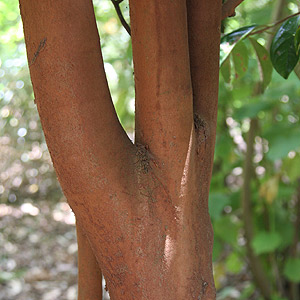
Camellia crapnelliana or Crapnell’s Camellia with its outstanding ochre – brown bark and large seed pods makes a great small specimen tree.
The seed pods can get to be as large as an apple, an amazing sight when on the tree.
And that is without the pretty white flowers and egg yolk yellow stamens that are real standouts in the spring garden.
Camellia crapnelliana will grow to 21ft+ and is originally from the mountains behind Hong Kong in southern China. Discovered by W. J. Tutcher it is rare in its native habitat.
If the height sounds a little to big it can easily be pruned back to a smaller size.
And why is this camellia not so common, its hard to grow except from seed, so it takes a while to get going and is not cheap.
Care
General Care
Although Camellia crapnelliana will grow in cooler climates it is unlikely to flower, so grow it for its trunk and foliage in cooler zones.
Like all camellias C. crapnelliana prefers a rich acidic moist soil and protection from the hot afternoon sun. An excellent choice for planting beneath larger trees, out near the drip-line where they get good dappled shade.
- Regarded as hardy to USDA Zones 8 – 10 or 11.
- Prefers a slightly acidic soil
- Humus rich moist but well drained soil.
- White flowers with a large boss of yellow stamens in the centre.
- Large brown seed capsules that follow the flowers are the largest seed pods of all of the camellias
Pruning
Rarely needed as the plant is slow growing with a good natural habit. However you can tip prune from a young age to get a bushier growth habit.
Pruning however can cause the wonderful trunk to become less of a feature in the garden.
Varieties
This is the species, very rare in the wild and now carefully conserved in Hong Kong. No know varieties or cultivars at the time of writing.
Propagation
Propagation from seed is actually easy if you give this plant the right conditions and seed is fresh. In nature the seed husk acts as a medium for growth. The seed actually sends its first roots into the husk, which provides moisture and nutrients and then decomposes
- Fresh seed should be used.
- Seed needs to be kept moist.
Where to buy
Offered by good Camellia specialists only.

